Business and Administration Diploma: Unit Summaries and Analysis
VerifiedAdded on 2020/06/04
|23
|6953
|209
Homework Assignment
AI Summary
This document presents a comprehensive overview of various units covered in a Level 3 Business and Administration Diploma, providing detailed summaries and analyses of key concepts. The assignment delves into the best practices for developing effective presentations, including design, content, and audience consideration. It explores the importance of administrative support for meetings, covering topics such as meeting purposes, attendance, resources, and the roles of the chair and secretary. Furthermore, the document examines employee rights and responsibilities, information management systems, and the production of meeting minutes. It also addresses the effective use of email and the resolution of customer complaints. The assignment offers practical insights and real-world applications, drawing on various sources to provide a well-rounded understanding of the topics. References to books and journals are included to support the information presented.

UNIT 10; 21; 24; 27; 32;
52; 54; 73
52; 54; 73
Paraphrase This Document
Need a fresh take? Get an instant paraphrase of this document with our AI Paraphraser
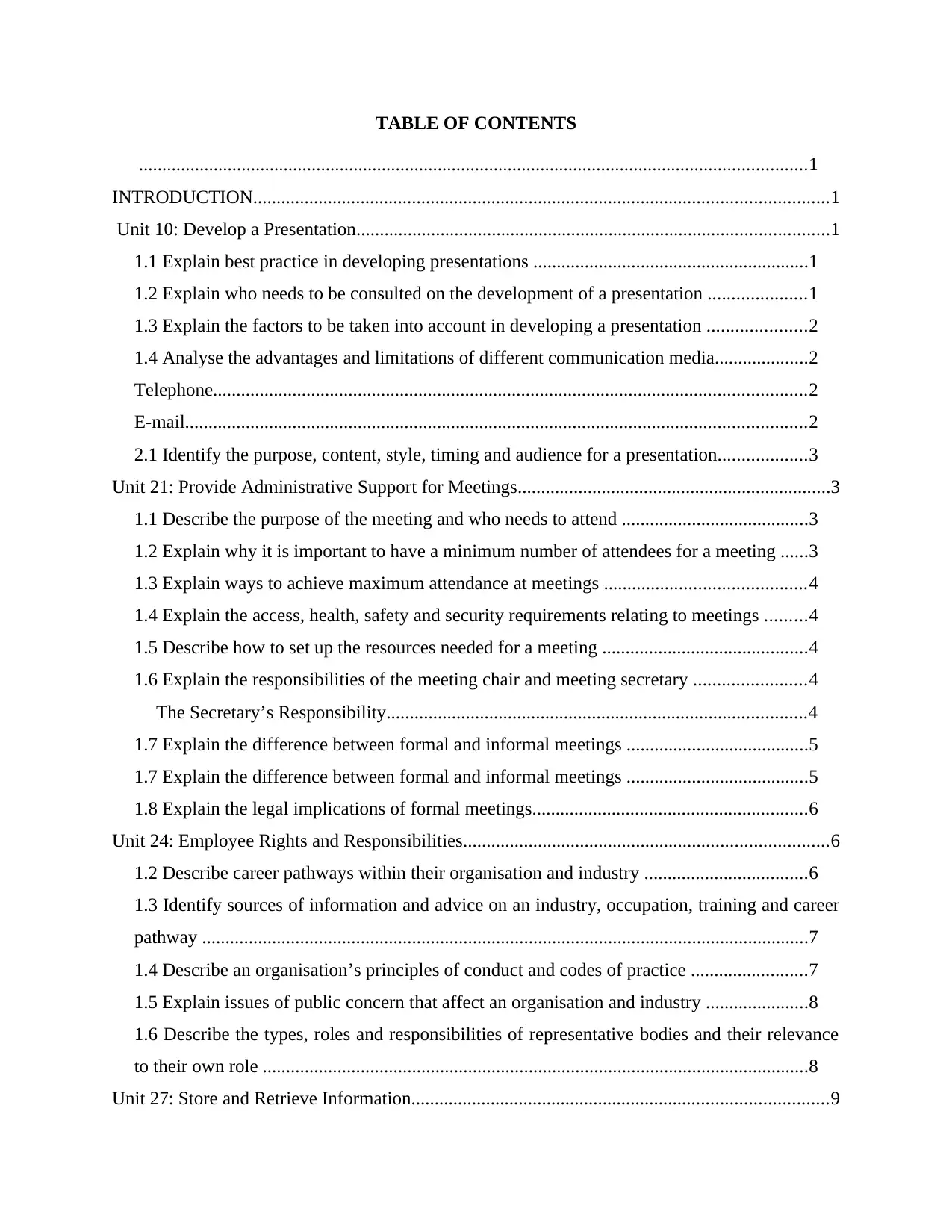
TABLE OF CONTENTS
...............................................................................................................................................1
INTRODUCTION...........................................................................................................................1
Unit 10: Develop a Presentation.....................................................................................................1
1.1 Explain best practice in developing presentations ...........................................................1
1.2 Explain who needs to be consulted on the development of a presentation .....................1
1.3 Explain the factors to be taken into account in developing a presentation .....................2
1.4 Analyse the advantages and limitations of different communication media....................2
Telephone...............................................................................................................................2
E-mail.....................................................................................................................................2
2.1 Identify the purpose, content, style, timing and audience for a presentation...................3
Unit 21: Provide Administrative Support for Meetings...................................................................3
1.1 Describe the purpose of the meeting and who needs to attend ........................................3
1.2 Explain why it is important to have a minimum number of attendees for a meeting ......3
1.3 Explain ways to achieve maximum attendance at meetings ...........................................4
1.4 Explain the access, health, safety and security requirements relating to meetings .........4
1.5 Describe how to set up the resources needed for a meeting ............................................4
1.6 Explain the responsibilities of the meeting chair and meeting secretary ........................4
The Secretary’s Responsibility..........................................................................................4
1.7 Explain the difference between formal and informal meetings .......................................5
1.7 Explain the difference between formal and informal meetings .......................................5
1.8 Explain the legal implications of formal meetings...........................................................6
Unit 24: Employee Rights and Responsibilities..............................................................................6
1.2 Describe career pathways within their organisation and industry ...................................6
1.3 Identify sources of information and advice on an industry, occupation, training and career
pathway ..................................................................................................................................7
1.4 Describe an organisation’s principles of conduct and codes of practice .........................7
1.5 Explain issues of public concern that affect an organisation and industry ......................8
1.6 Describe the types, roles and responsibilities of representative bodies and their relevance
to their own role .....................................................................................................................8
Unit 27: Store and Retrieve Information.........................................................................................9
...............................................................................................................................................1
INTRODUCTION...........................................................................................................................1
Unit 10: Develop a Presentation.....................................................................................................1
1.1 Explain best practice in developing presentations ...........................................................1
1.2 Explain who needs to be consulted on the development of a presentation .....................1
1.3 Explain the factors to be taken into account in developing a presentation .....................2
1.4 Analyse the advantages and limitations of different communication media....................2
Telephone...............................................................................................................................2
E-mail.....................................................................................................................................2
2.1 Identify the purpose, content, style, timing and audience for a presentation...................3
Unit 21: Provide Administrative Support for Meetings...................................................................3
1.1 Describe the purpose of the meeting and who needs to attend ........................................3
1.2 Explain why it is important to have a minimum number of attendees for a meeting ......3
1.3 Explain ways to achieve maximum attendance at meetings ...........................................4
1.4 Explain the access, health, safety and security requirements relating to meetings .........4
1.5 Describe how to set up the resources needed for a meeting ............................................4
1.6 Explain the responsibilities of the meeting chair and meeting secretary ........................4
The Secretary’s Responsibility..........................................................................................4
1.7 Explain the difference between formal and informal meetings .......................................5
1.7 Explain the difference between formal and informal meetings .......................................5
1.8 Explain the legal implications of formal meetings...........................................................6
Unit 24: Employee Rights and Responsibilities..............................................................................6
1.2 Describe career pathways within their organisation and industry ...................................6
1.3 Identify sources of information and advice on an industry, occupation, training and career
pathway ..................................................................................................................................7
1.4 Describe an organisation’s principles of conduct and codes of practice .........................7
1.5 Explain issues of public concern that affect an organisation and industry ......................8
1.6 Describe the types, roles and responsibilities of representative bodies and their relevance
to their own role .....................................................................................................................8
Unit 27: Store and Retrieve Information.........................................................................................9
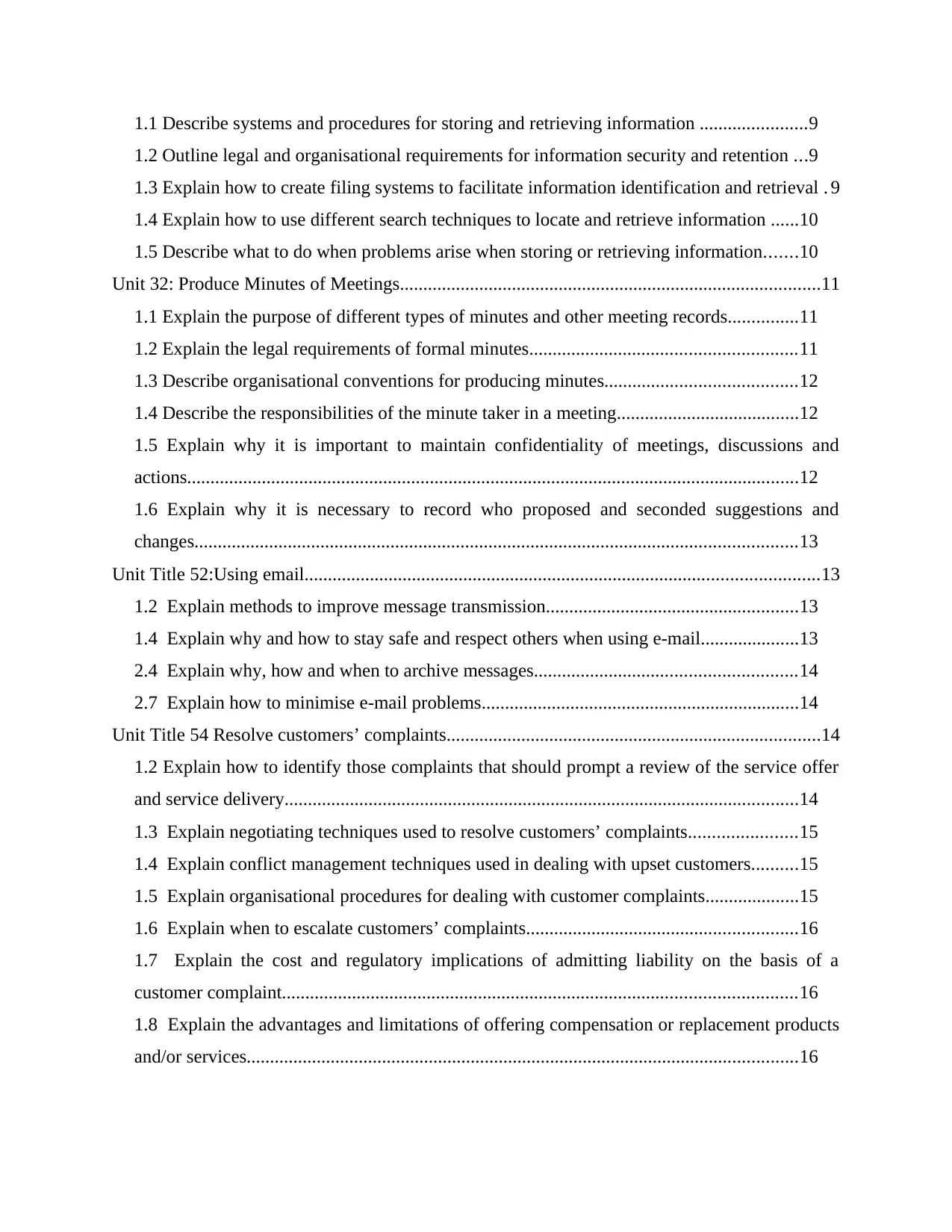
1.1 Describe systems and procedures for storing and retrieving information .......................9
1.2 Outline legal and organisational requirements for information security and retention ...9
1.3 Explain how to create filing systems to facilitate information identification and retrieval . 9
1.4 Explain how to use different search techniques to locate and retrieve information ......10
1.5 Describe what to do when problems arise when storing or retrieving information.......10
Unit 32: Produce Minutes of Meetings..........................................................................................11
1.1 Explain the purpose of different types of minutes and other meeting records...............11
1.2 Explain the legal requirements of formal minutes.........................................................11
1.3 Describe organisational conventions for producing minutes.........................................12
1.4 Describe the responsibilities of the minute taker in a meeting.......................................12
1.5 Explain why it is important to maintain confidentiality of meetings, discussions and
actions...................................................................................................................................12
1.6 Explain why it is necessary to record who proposed and seconded suggestions and
changes.................................................................................................................................13
Unit Title 52:Using email..............................................................................................................13
1.2 Explain methods to improve message transmission......................................................13
1.4 Explain why and how to stay safe and respect others when using e-mail.....................13
2.4 Explain why, how and when to archive messages........................................................14
2.7 Explain how to minimise e-mail problems....................................................................14
Unit Title 54 Resolve customers’ complaints................................................................................14
1.2 Explain how to identify those complaints that should prompt a review of the service offer
and service delivery..............................................................................................................14
1.3 Explain negotiating techniques used to resolve customers’ complaints.......................15
1.4 Explain conflict management techniques used in dealing with upset customers..........15
1.5 Explain organisational procedures for dealing with customer complaints....................15
1.6 Explain when to escalate customers’ complaints..........................................................16
1.7 Explain the cost and regulatory implications of admitting liability on the basis of a
customer complaint..............................................................................................................16
1.8 Explain the advantages and limitations of offering compensation or replacement products
and/or services......................................................................................................................16
1.2 Outline legal and organisational requirements for information security and retention ...9
1.3 Explain how to create filing systems to facilitate information identification and retrieval . 9
1.4 Explain how to use different search techniques to locate and retrieve information ......10
1.5 Describe what to do when problems arise when storing or retrieving information.......10
Unit 32: Produce Minutes of Meetings..........................................................................................11
1.1 Explain the purpose of different types of minutes and other meeting records...............11
1.2 Explain the legal requirements of formal minutes.........................................................11
1.3 Describe organisational conventions for producing minutes.........................................12
1.4 Describe the responsibilities of the minute taker in a meeting.......................................12
1.5 Explain why it is important to maintain confidentiality of meetings, discussions and
actions...................................................................................................................................12
1.6 Explain why it is necessary to record who proposed and seconded suggestions and
changes.................................................................................................................................13
Unit Title 52:Using email..............................................................................................................13
1.2 Explain methods to improve message transmission......................................................13
1.4 Explain why and how to stay safe and respect others when using e-mail.....................13
2.4 Explain why, how and when to archive messages........................................................14
2.7 Explain how to minimise e-mail problems....................................................................14
Unit Title 54 Resolve customers’ complaints................................................................................14
1.2 Explain how to identify those complaints that should prompt a review of the service offer
and service delivery..............................................................................................................14
1.3 Explain negotiating techniques used to resolve customers’ complaints.......................15
1.4 Explain conflict management techniques used in dealing with upset customers..........15
1.5 Explain organisational procedures for dealing with customer complaints....................15
1.6 Explain when to escalate customers’ complaints..........................................................16
1.7 Explain the cost and regulatory implications of admitting liability on the basis of a
customer complaint..............................................................................................................16
1.8 Explain the advantages and limitations of offering compensation or replacement products
and/or services......................................................................................................................16
⊘ This is a preview!⊘
Do you want full access?
Subscribe today to unlock all pages.

Trusted by 1+ million students worldwide
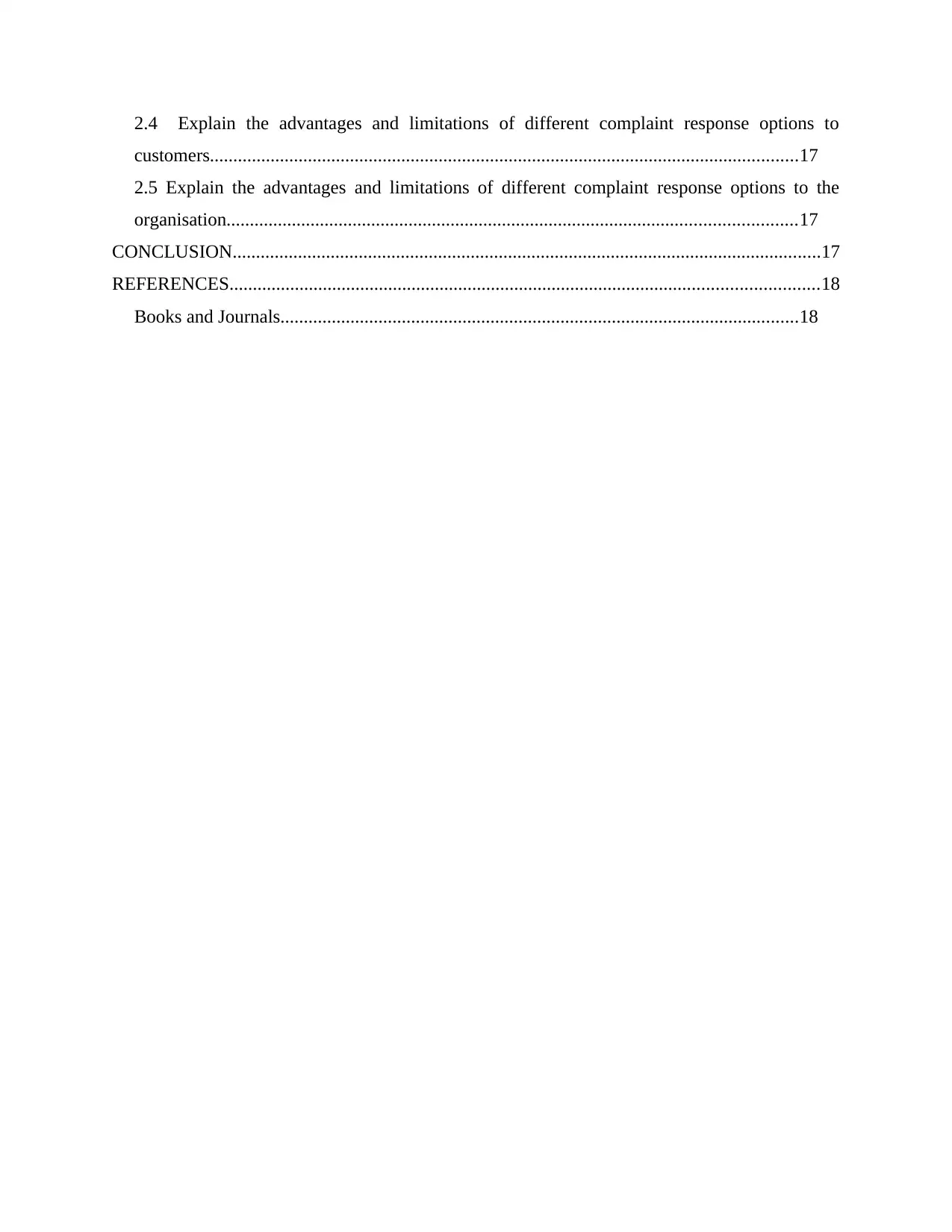
2.4 Explain the advantages and limitations of different complaint response options to
customers..............................................................................................................................17
2.5 Explain the advantages and limitations of different complaint response options to the
organisation..........................................................................................................................17
CONCLUSION..............................................................................................................................17
REFERENCES..............................................................................................................................18
Books and Journals...............................................................................................................18
customers..............................................................................................................................17
2.5 Explain the advantages and limitations of different complaint response options to the
organisation..........................................................................................................................17
CONCLUSION..............................................................................................................................17
REFERENCES..............................................................................................................................18
Books and Journals...............................................................................................................18
Paraphrase This Document
Need a fresh take? Get an instant paraphrase of this document with our AI Paraphraser
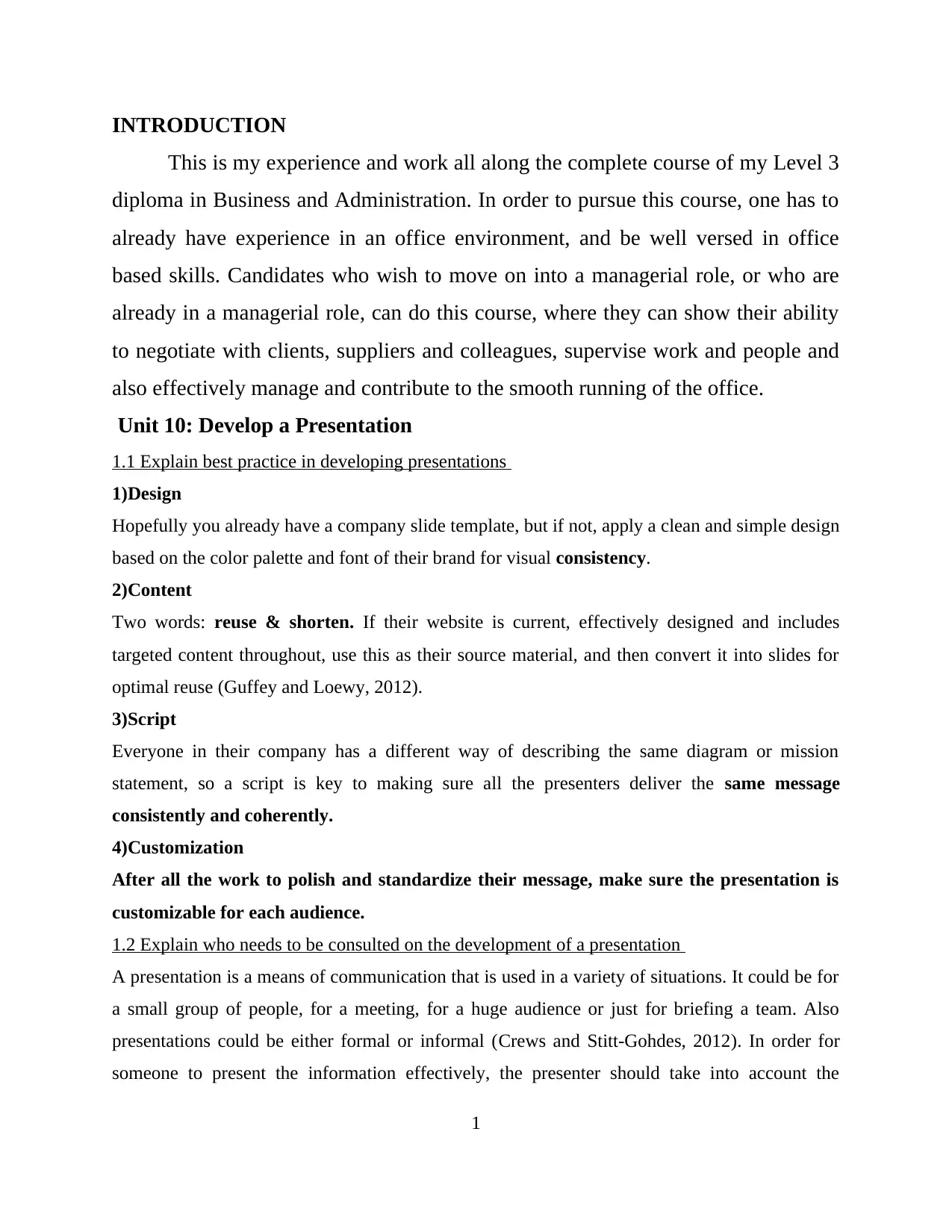
INTRODUCTION
This is my experience and work all along the complete course of my Level 3
diploma in Business and Administration. In order to pursue this course, one has to
already have experience in an office environment, and be well versed in office
based skills. Candidates who wish to move on into a managerial role, or who are
already in a managerial role, can do this course, where they can show their ability
to negotiate with clients, suppliers and colleagues, supervise work and people and
also effectively manage and contribute to the smooth running of the office.
Unit 10: Develop a Presentation
1.1 Explain best practice in developing presentations
1)Design
Hopefully you already have a company slide template, but if not, apply a clean and simple design
based on the color palette and font of their brand for visual consistency.
2)Content
Two words: reuse & shorten. If their website is current, effectively designed and includes
targeted content throughout, use this as their source material, and then convert it into slides for
optimal reuse (Guffey and Loewy, 2012).
3)Script
Everyone in their company has a different way of describing the same diagram or mission
statement, so a script is key to making sure all the presenters deliver the same message
consistently and coherently.
4)Customization
After all the work to polish and standardize their message, make sure the presentation is
customizable for each audience.
1.2 Explain who needs to be consulted on the development of a presentation
A presentation is a means of communication that is used in a variety of situations. It could be for
a small group of people, for a meeting, for a huge audience or just for briefing a team. Also
presentations could be either formal or informal (Crews and Stitt-Gohdes, 2012). In order for
someone to present the information effectively, the presenter should take into account the
1
This is my experience and work all along the complete course of my Level 3
diploma in Business and Administration. In order to pursue this course, one has to
already have experience in an office environment, and be well versed in office
based skills. Candidates who wish to move on into a managerial role, or who are
already in a managerial role, can do this course, where they can show their ability
to negotiate with clients, suppliers and colleagues, supervise work and people and
also effectively manage and contribute to the smooth running of the office.
Unit 10: Develop a Presentation
1.1 Explain best practice in developing presentations
1)Design
Hopefully you already have a company slide template, but if not, apply a clean and simple design
based on the color palette and font of their brand for visual consistency.
2)Content
Two words: reuse & shorten. If their website is current, effectively designed and includes
targeted content throughout, use this as their source material, and then convert it into slides for
optimal reuse (Guffey and Loewy, 2012).
3)Script
Everyone in their company has a different way of describing the same diagram or mission
statement, so a script is key to making sure all the presenters deliver the same message
consistently and coherently.
4)Customization
After all the work to polish and standardize their message, make sure the presentation is
customizable for each audience.
1.2 Explain who needs to be consulted on the development of a presentation
A presentation is a means of communication that is used in a variety of situations. It could be for
a small group of people, for a meeting, for a huge audience or just for briefing a team. Also
presentations could be either formal or informal (Crews and Stitt-Gohdes, 2012). In order for
someone to present the information effectively, the presenter should take into account the
1

audience, their level of knowledge on the topic that one will be presenting and their interests, as
an efficient presentation needs to focus on these and the presenter needs to be prepared to
respond to the audience.
1.3 Explain the factors to be taken into account in developing a presentation
Before even preparing for the presentation, one needs to get in touch or consult with the
coordinator or the person in charge of the event, be it a meeting or a conference or a discussion.
It would also be better if possible to get in touch with a few members from the audience to get an
idea of what their knowledge is relating to what will be presented, what they would like to gain
or understand from this presentation, what they would like to benefit from through this
presentation and what they will be doing (in terms of applying the information presented)
following the presentation (Meredith, 2012). In order to achieve a positive outcome through the
presentation, careful consultation with the coordinator or person in charge or the audience or all
if possible is very important. This will help one to effectively plan the presentation and make
decisions relating to the design and presentation.
1.4 Analyse the advantages and limitations of different communication media
Telephone
Land or mobile telephones have taken up the communication slack in businesses where
distance and travel prevent face-to-face conversation. The telephone still allows immediate
interaction between two parties in the communication (Conrad and Newberry, 2012). Mobile
phones also expand their ability to communicate with distant workers or offices. The lack of
nonverbal or facial expressions remove those elements from the message. This can inhibit the
ability to interpret the context or emotion of a message sender. The phone is also less personal
than a face-to-face meeting.
E-mail
E-mail is a vital communication channel in geographically dispersed companies or ones
in which employees travel. E-mail allows for more flexible response times. You can send a
message one day and receive a response in a few hours or the next day. It allows for conversation
that isn't time-pressured, but can serve for fast turnaround times. It also allows for the inclusion
of files, such as documents or images. E-mail is less personal than either face-to-face or phone.
The missing context of the message may lead to misunderstandings or misinterpreted messages
2
an efficient presentation needs to focus on these and the presenter needs to be prepared to
respond to the audience.
1.3 Explain the factors to be taken into account in developing a presentation
Before even preparing for the presentation, one needs to get in touch or consult with the
coordinator or the person in charge of the event, be it a meeting or a conference or a discussion.
It would also be better if possible to get in touch with a few members from the audience to get an
idea of what their knowledge is relating to what will be presented, what they would like to gain
or understand from this presentation, what they would like to benefit from through this
presentation and what they will be doing (in terms of applying the information presented)
following the presentation (Meredith, 2012). In order to achieve a positive outcome through the
presentation, careful consultation with the coordinator or person in charge or the audience or all
if possible is very important. This will help one to effectively plan the presentation and make
decisions relating to the design and presentation.
1.4 Analyse the advantages and limitations of different communication media
Telephone
Land or mobile telephones have taken up the communication slack in businesses where
distance and travel prevent face-to-face conversation. The telephone still allows immediate
interaction between two parties in the communication (Conrad and Newberry, 2012). Mobile
phones also expand their ability to communicate with distant workers or offices. The lack of
nonverbal or facial expressions remove those elements from the message. This can inhibit the
ability to interpret the context or emotion of a message sender. The phone is also less personal
than a face-to-face meeting.
E-mail is a vital communication channel in geographically dispersed companies or ones
in which employees travel. E-mail allows for more flexible response times. You can send a
message one day and receive a response in a few hours or the next day. It allows for conversation
that isn't time-pressured, but can serve for fast turnaround times. It also allows for the inclusion
of files, such as documents or images. E-mail is less personal than either face-to-face or phone.
The missing context of the message may lead to misunderstandings or misinterpreted messages
2
⊘ This is a preview!⊘
Do you want full access?
Subscribe today to unlock all pages.

Trusted by 1+ million students worldwide
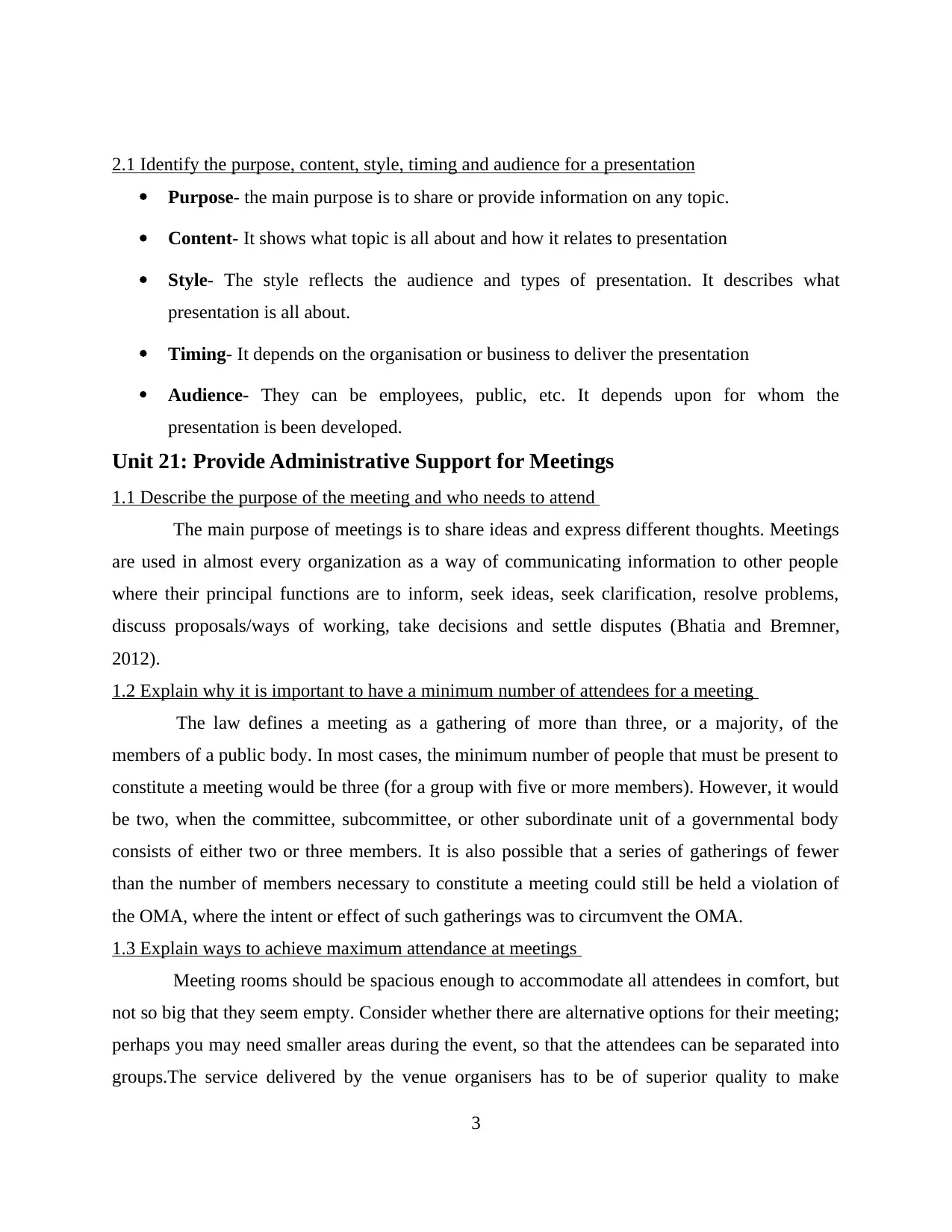
2.1 Identify the purpose, content, style, timing and audience for a presentation
Purpose- the main purpose is to share or provide information on any topic.
Content- It shows what topic is all about and how it relates to presentation
Style- The style reflects the audience and types of presentation. It describes what
presentation is all about.
Timing- It depends on the organisation or business to deliver the presentation
Audience- They can be employees, public, etc. It depends upon for whom the
presentation is been developed.
Unit 21: Provide Administrative Support for Meetings
1.1 Describe the purpose of the meeting and who needs to attend
The main purpose of meetings is to share ideas and express different thoughts. Meetings
are used in almost every organization as a way of communicating information to other people
where their principal functions are to inform, seek ideas, seek clarification, resolve problems,
discuss proposals/ways of working, take decisions and settle disputes (Bhatia and Bremner,
2012).
1.2 Explain why it is important to have a minimum number of attendees for a meeting
The law defines a meeting as a gathering of more than three, or a majority, of the
members of a public body. In most cases, the minimum number of people that must be present to
constitute a meeting would be three (for a group with five or more members). However, it would
be two, when the committee, subcommittee, or other subordinate unit of a governmental body
consists of either two or three members. It is also possible that a series of gatherings of fewer
than the number of members necessary to constitute a meeting could still be held a violation of
the OMA, where the intent or effect of such gatherings was to circumvent the OMA.
1.3 Explain ways to achieve maximum attendance at meetings
Meeting rooms should be spacious enough to accommodate all attendees in comfort, but
not so big that they seem empty. Consider whether there are alternative options for their meeting;
perhaps you may need smaller areas during the event, so that the attendees can be separated into
groups.The service delivered by the venue organisers has to be of superior quality to make
3
Purpose- the main purpose is to share or provide information on any topic.
Content- It shows what topic is all about and how it relates to presentation
Style- The style reflects the audience and types of presentation. It describes what
presentation is all about.
Timing- It depends on the organisation or business to deliver the presentation
Audience- They can be employees, public, etc. It depends upon for whom the
presentation is been developed.
Unit 21: Provide Administrative Support for Meetings
1.1 Describe the purpose of the meeting and who needs to attend
The main purpose of meetings is to share ideas and express different thoughts. Meetings
are used in almost every organization as a way of communicating information to other people
where their principal functions are to inform, seek ideas, seek clarification, resolve problems,
discuss proposals/ways of working, take decisions and settle disputes (Bhatia and Bremner,
2012).
1.2 Explain why it is important to have a minimum number of attendees for a meeting
The law defines a meeting as a gathering of more than three, or a majority, of the
members of a public body. In most cases, the minimum number of people that must be present to
constitute a meeting would be three (for a group with five or more members). However, it would
be two, when the committee, subcommittee, or other subordinate unit of a governmental body
consists of either two or three members. It is also possible that a series of gatherings of fewer
than the number of members necessary to constitute a meeting could still be held a violation of
the OMA, where the intent or effect of such gatherings was to circumvent the OMA.
1.3 Explain ways to achieve maximum attendance at meetings
Meeting rooms should be spacious enough to accommodate all attendees in comfort, but
not so big that they seem empty. Consider whether there are alternative options for their meeting;
perhaps you may need smaller areas during the event, so that the attendees can be separated into
groups.The service delivered by the venue organisers has to be of superior quality to make
3
Paraphrase This Document
Need a fresh take? Get an instant paraphrase of this document with our AI Paraphraser

attendees want to return for other events. From the start of the meeting to the return journey
home, guests should feel that they have attended a successful gathering.
1.4 Explain the access, health, safety and security requirements relating to meetings
Health, safety and security are the most important factors to be considered while
conducting a meeting.
Check to see if the venue is a safe structure for the kind of meeting taking place.
Check that electrical wires are secured properly and not trailing on the floor.
Make sure that the equipment to be used, like laptops and OHPs, is good working order
and has passed ICT testing to avoid safety issues (Hynes, 2012).
Make sure that any confidential documents taken to the meeting are not left behind and
are brought back safely. Also, make sure that only authorised people are allowed access
to those documents.
1.5 Describe how to set up the resources needed for a meeting
Identify the purpose of the meeting
Make sure you really need a meeting
Develop a preliminary agenda
Select the right participants
Assign roles to participants
1.6 Explain the responsibilities of the meeting chair and meeting secretary
The Secretary’s Responsibility
The secretary’s role in any formal group is to be guardian of the process of meetings. They are
usually the person who makes the arrangements for the meetings, including AGMs, and keeps
formal records of the group’s process and decisions: the minutes of the meeting. The role of the
Chair is to ensure that an accurate record of a meeting is made. The chair of the meeting has a
responsibility to
Help the minute taker with agreeing agenda items.
Follow the agenda items in sequence.
Informing the minute taker of any items to be removed from the agreed agenda.
4
home, guests should feel that they have attended a successful gathering.
1.4 Explain the access, health, safety and security requirements relating to meetings
Health, safety and security are the most important factors to be considered while
conducting a meeting.
Check to see if the venue is a safe structure for the kind of meeting taking place.
Check that electrical wires are secured properly and not trailing on the floor.
Make sure that the equipment to be used, like laptops and OHPs, is good working order
and has passed ICT testing to avoid safety issues (Hynes, 2012).
Make sure that any confidential documents taken to the meeting are not left behind and
are brought back safely. Also, make sure that only authorised people are allowed access
to those documents.
1.5 Describe how to set up the resources needed for a meeting
Identify the purpose of the meeting
Make sure you really need a meeting
Develop a preliminary agenda
Select the right participants
Assign roles to participants
1.6 Explain the responsibilities of the meeting chair and meeting secretary
The Secretary’s Responsibility
The secretary’s role in any formal group is to be guardian of the process of meetings. They are
usually the person who makes the arrangements for the meetings, including AGMs, and keeps
formal records of the group’s process and decisions: the minutes of the meeting. The role of the
Chair is to ensure that an accurate record of a meeting is made. The chair of the meeting has a
responsibility to
Help the minute taker with agreeing agenda items.
Follow the agenda items in sequence.
Informing the minute taker of any items to be removed from the agreed agenda.
4
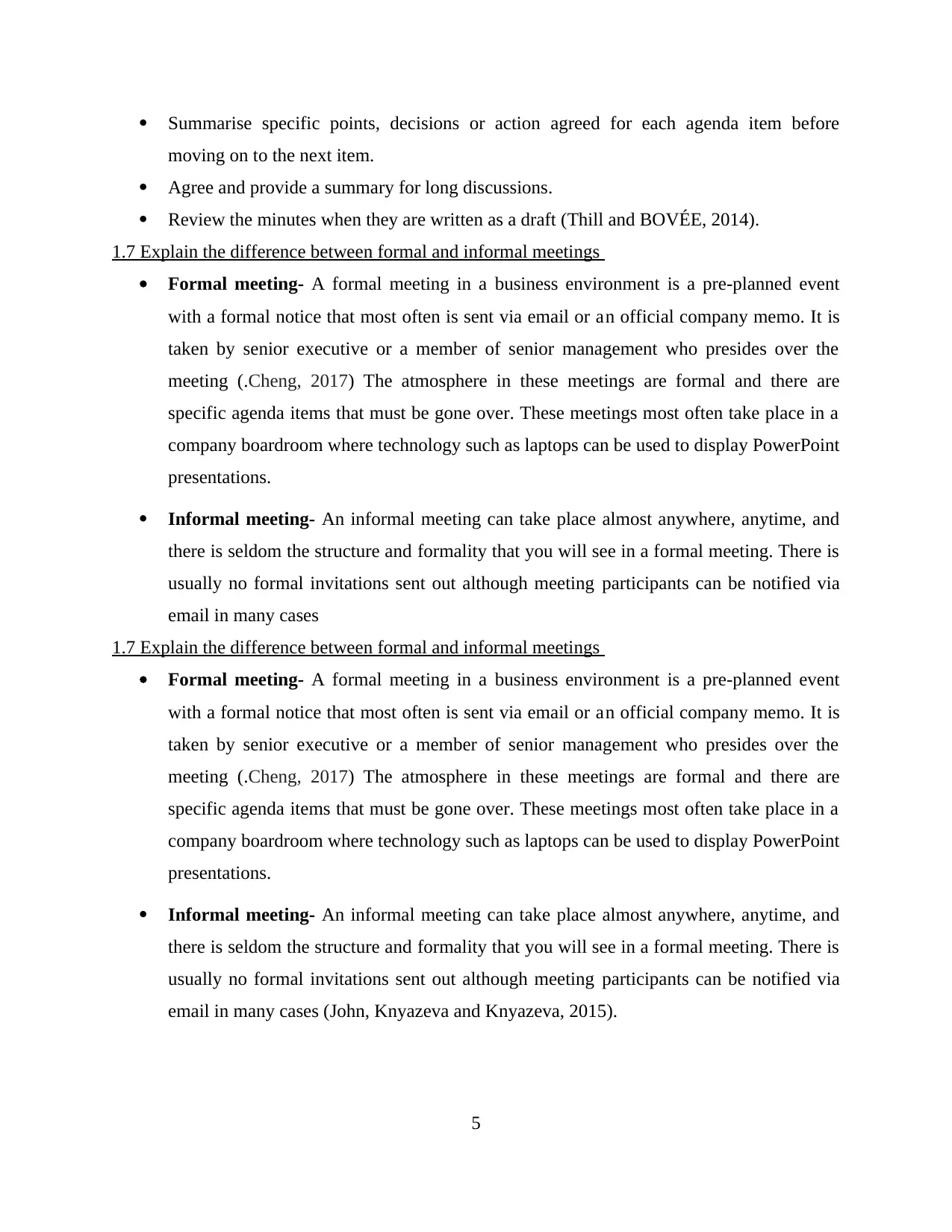
Summarise specific points, decisions or action agreed for each agenda item before
moving on to the next item.
Agree and provide a summary for long discussions.
Review the minutes when they are written as a draft (Thill and BOVÉE, 2014).
1.7 Explain the difference between formal and informal meetings
Formal meeting- A formal meeting in a business environment is a pre-planned event
with a formal notice that most often is sent via email or an official company memo. It is
taken by senior executive or a member of senior management who presides over the
meeting (.Cheng, 2017) The atmosphere in these meetings are formal and there are
specific agenda items that must be gone over. These meetings most often take place in a
company boardroom where technology such as laptops can be used to display PowerPoint
presentations.
Informal meeting- An informal meeting can take place almost anywhere, anytime, and
there is seldom the structure and formality that you will see in a formal meeting. There is
usually no formal invitations sent out although meeting participants can be notified via
email in many cases
1.7 Explain the difference between formal and informal meetings
Formal meeting- A formal meeting in a business environment is a pre-planned event
with a formal notice that most often is sent via email or an official company memo. It is
taken by senior executive or a member of senior management who presides over the
meeting (.Cheng, 2017) The atmosphere in these meetings are formal and there are
specific agenda items that must be gone over. These meetings most often take place in a
company boardroom where technology such as laptops can be used to display PowerPoint
presentations.
Informal meeting- An informal meeting can take place almost anywhere, anytime, and
there is seldom the structure and formality that you will see in a formal meeting. There is
usually no formal invitations sent out although meeting participants can be notified via
email in many cases (John, Knyazeva and Knyazeva, 2015).
5
moving on to the next item.
Agree and provide a summary for long discussions.
Review the minutes when they are written as a draft (Thill and BOVÉE, 2014).
1.7 Explain the difference between formal and informal meetings
Formal meeting- A formal meeting in a business environment is a pre-planned event
with a formal notice that most often is sent via email or an official company memo. It is
taken by senior executive or a member of senior management who presides over the
meeting (.Cheng, 2017) The atmosphere in these meetings are formal and there are
specific agenda items that must be gone over. These meetings most often take place in a
company boardroom where technology such as laptops can be used to display PowerPoint
presentations.
Informal meeting- An informal meeting can take place almost anywhere, anytime, and
there is seldom the structure and formality that you will see in a formal meeting. There is
usually no formal invitations sent out although meeting participants can be notified via
email in many cases
1.7 Explain the difference between formal and informal meetings
Formal meeting- A formal meeting in a business environment is a pre-planned event
with a formal notice that most often is sent via email or an official company memo. It is
taken by senior executive or a member of senior management who presides over the
meeting (.Cheng, 2017) The atmosphere in these meetings are formal and there are
specific agenda items that must be gone over. These meetings most often take place in a
company boardroom where technology such as laptops can be used to display PowerPoint
presentations.
Informal meeting- An informal meeting can take place almost anywhere, anytime, and
there is seldom the structure and formality that you will see in a formal meeting. There is
usually no formal invitations sent out although meeting participants can be notified via
email in many cases (John, Knyazeva and Knyazeva, 2015).
5
⊘ This is a preview!⊘
Do you want full access?
Subscribe today to unlock all pages.

Trusted by 1+ million students worldwide
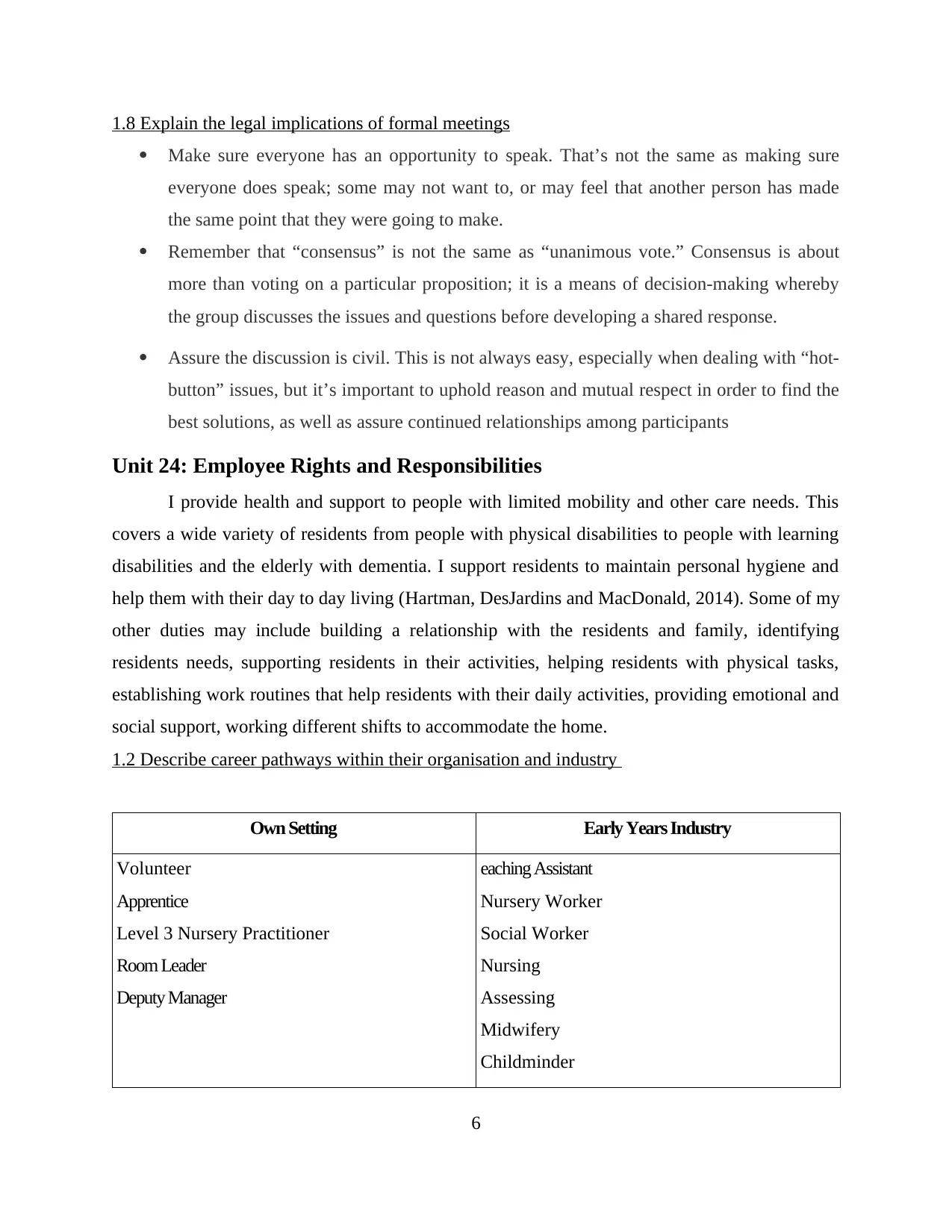
1.8 Explain the legal implications of formal meetings
Make sure everyone has an opportunity to speak. That’s not the same as making sure
everyone does speak; some may not want to, or may feel that another person has made
the same point that they were going to make.
Remember that “consensus” is not the same as “unanimous vote.” Consensus is about
more than voting on a particular proposition; it is a means of decision-making whereby
the group discusses the issues and questions before developing a shared response.
Assure the discussion is civil. This is not always easy, especially when dealing with “hot-
button” issues, but it’s important to uphold reason and mutual respect in order to find the
best solutions, as well as assure continued relationships among participants
Unit 24: Employee Rights and Responsibilities
I provide health and support to people with limited mobility and other care needs. This
covers a wide variety of residents from people with physical disabilities to people with learning
disabilities and the elderly with dementia. I support residents to maintain personal hygiene and
help them with their day to day living (Hartman, DesJardins and MacDonald, 2014). Some of my
other duties may include building a relationship with the residents and family, identifying
residents needs, supporting residents in their activities, helping residents with physical tasks,
establishing work routines that help residents with their daily activities, providing emotional and
social support, working different shifts to accommodate the home.
1.2 Describe career pathways within their organisation and industry
Own Setting Early Years Industry
Volunteer
Apprentice
Level 3 Nursery Practitioner
Room Leader
Deputy Manager
eaching Assistant
Nursery Worker
Social Worker
Nursing
Assessing
Midwifery
Childminder
6
Make sure everyone has an opportunity to speak. That’s not the same as making sure
everyone does speak; some may not want to, or may feel that another person has made
the same point that they were going to make.
Remember that “consensus” is not the same as “unanimous vote.” Consensus is about
more than voting on a particular proposition; it is a means of decision-making whereby
the group discusses the issues and questions before developing a shared response.
Assure the discussion is civil. This is not always easy, especially when dealing with “hot-
button” issues, but it’s important to uphold reason and mutual respect in order to find the
best solutions, as well as assure continued relationships among participants
Unit 24: Employee Rights and Responsibilities
I provide health and support to people with limited mobility and other care needs. This
covers a wide variety of residents from people with physical disabilities to people with learning
disabilities and the elderly with dementia. I support residents to maintain personal hygiene and
help them with their day to day living (Hartman, DesJardins and MacDonald, 2014). Some of my
other duties may include building a relationship with the residents and family, identifying
residents needs, supporting residents in their activities, helping residents with physical tasks,
establishing work routines that help residents with their daily activities, providing emotional and
social support, working different shifts to accommodate the home.
1.2 Describe career pathways within their organisation and industry
Own Setting Early Years Industry
Volunteer
Apprentice
Level 3 Nursery Practitioner
Room Leader
Deputy Manager
eaching Assistant
Nursery Worker
Social Worker
Nursing
Assessing
Midwifery
Childminder
6
Paraphrase This Document
Need a fresh take? Get an instant paraphrase of this document with our AI Paraphraser
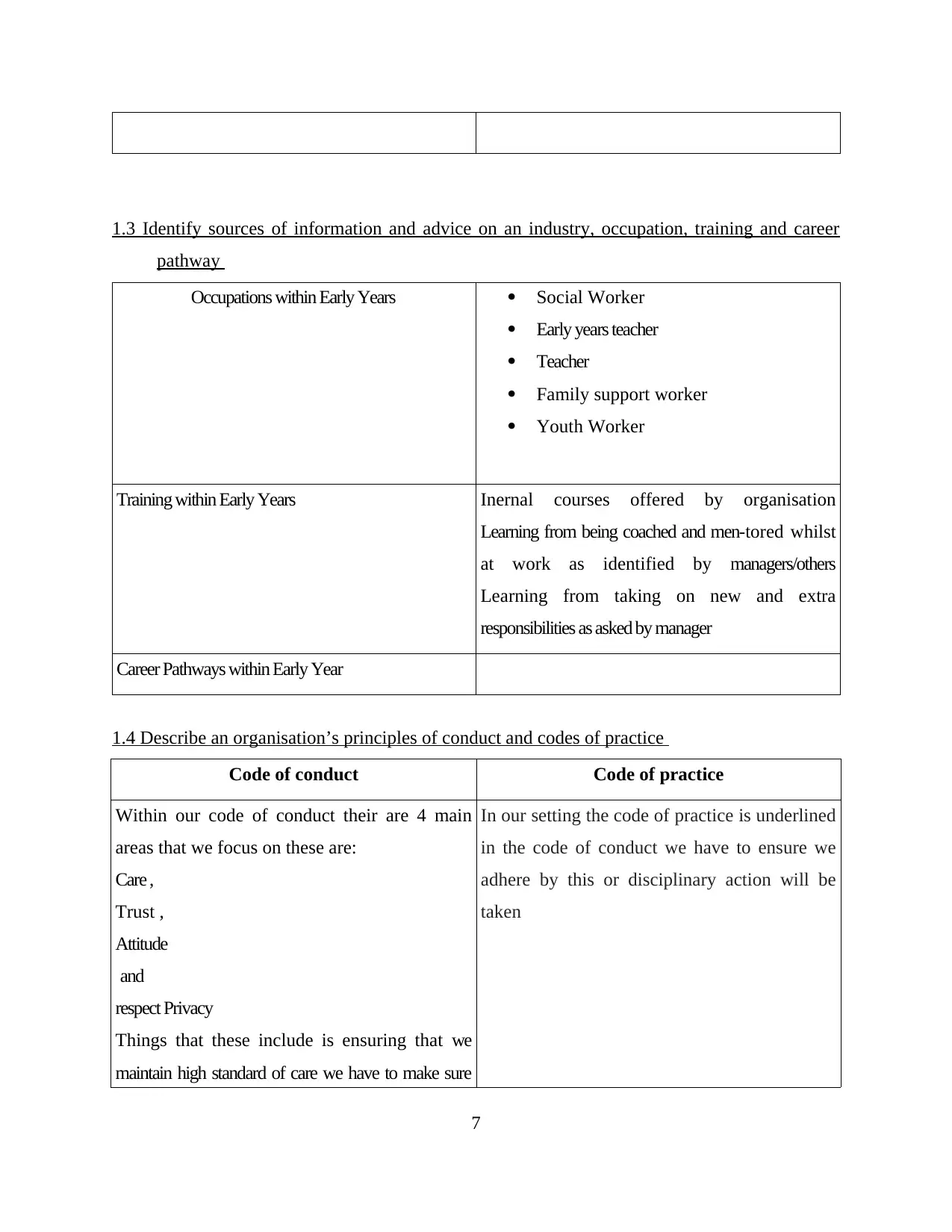
1.3 Identify sources of information and advice on an industry, occupation, training and career
pathway
Occupations within Early Years Social Worker
Early years teacher
Teacher
Family support worker
Youth Worker
Training within Early Years Inernal courses offered by organisation
Learning from being coached and men-tored whilst
at work as identified by managers/others
Learning from taking on new and extra
responsibilities as asked by manager
Career Pathways within Early Year
1.4 Describe an organisation’s principles of conduct and codes of practice
Code of conduct Code of practice
Within our code of conduct their are 4 main
areas that we focus on these are:
Care ,
Trust ,
Attitude
and
respect Privacy
Things that these include is ensuring that we
maintain high standard of care we have to make sure
In our setting the code of practice is underlined
in the code of conduct we have to ensure we
adhere by this or disciplinary action will be
taken
7
pathway
Occupations within Early Years Social Worker
Early years teacher
Teacher
Family support worker
Youth Worker
Training within Early Years Inernal courses offered by organisation
Learning from being coached and men-tored whilst
at work as identified by managers/others
Learning from taking on new and extra
responsibilities as asked by manager
Career Pathways within Early Year
1.4 Describe an organisation’s principles of conduct and codes of practice
Code of conduct Code of practice
Within our code of conduct their are 4 main
areas that we focus on these are:
Care ,
Trust ,
Attitude
and
respect Privacy
Things that these include is ensuring that we
maintain high standard of care we have to make sure
In our setting the code of practice is underlined
in the code of conduct we have to ensure we
adhere by this or disciplinary action will be
taken
7
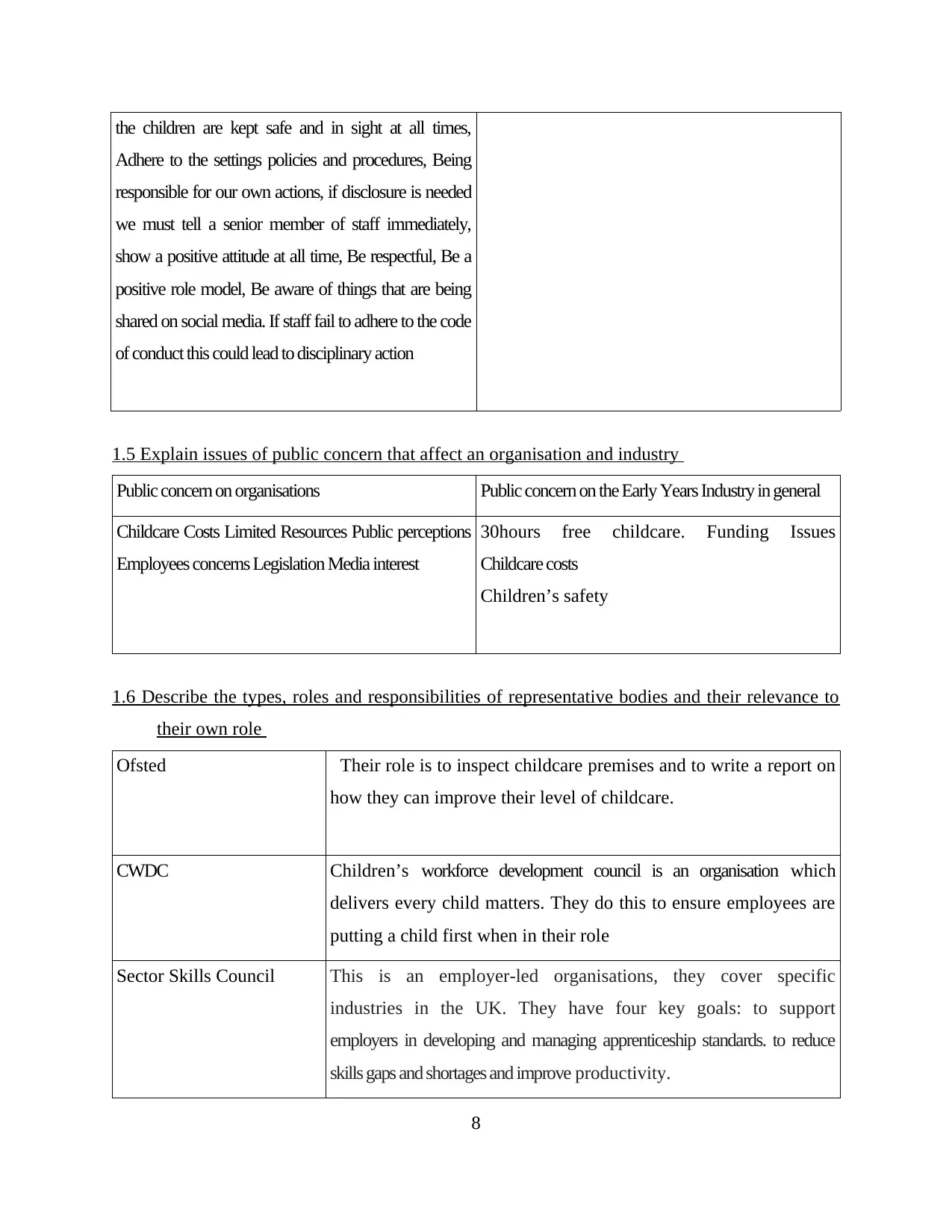
the children are kept safe and in sight at all times,
Adhere to the settings policies and procedures, Being
responsible for our own actions, if disclosure is needed
we must tell a senior member of staff immediately,
show a positive attitude at all time, Be respectful, Be a
positive role model, Be aware of things that are being
shared on social media. If staff fail to adhere to the code
of conduct this could lead to disciplinary action
1.5 Explain issues of public concern that affect an organisation and industry
Public concern on organisations Public concern on the Early Years Industry in general
Childcare Costs Limited Resources Public perceptions
Employees concerns Legislation Media interest
30hours free childcare. Funding Issues
Childcare costs
Children’s safety
1.6 Describe the types, roles and responsibilities of representative bodies and their relevance to
their own role
Ofsted Their role is to inspect childcare premises and to write a report on
how they can improve their level of childcare.
CWDC Children’s workforce development council is an organisation which
delivers every child matters. They do this to ensure employees are
putting a child first when in their role
Sector Skills Council This is an employer-led organisations, they cover specific
industries in the UK. They have four key goals: to support
employers in developing and managing apprenticeship standards. to reduce
skills gaps and shortages and improve productivity.
8
Adhere to the settings policies and procedures, Being
responsible for our own actions, if disclosure is needed
we must tell a senior member of staff immediately,
show a positive attitude at all time, Be respectful, Be a
positive role model, Be aware of things that are being
shared on social media. If staff fail to adhere to the code
of conduct this could lead to disciplinary action
1.5 Explain issues of public concern that affect an organisation and industry
Public concern on organisations Public concern on the Early Years Industry in general
Childcare Costs Limited Resources Public perceptions
Employees concerns Legislation Media interest
30hours free childcare. Funding Issues
Childcare costs
Children’s safety
1.6 Describe the types, roles and responsibilities of representative bodies and their relevance to
their own role
Ofsted Their role is to inspect childcare premises and to write a report on
how they can improve their level of childcare.
CWDC Children’s workforce development council is an organisation which
delivers every child matters. They do this to ensure employees are
putting a child first when in their role
Sector Skills Council This is an employer-led organisations, they cover specific
industries in the UK. They have four key goals: to support
employers in developing and managing apprenticeship standards. to reduce
skills gaps and shortages and improve productivity.
8
⊘ This is a preview!⊘
Do you want full access?
Subscribe today to unlock all pages.

Trusted by 1+ million students worldwide
1 out of 23
Related Documents
Your All-in-One AI-Powered Toolkit for Academic Success.
+13062052269
info@desklib.com
Available 24*7 on WhatsApp / Email
![[object Object]](/_next/static/media/star-bottom.7253800d.svg)
Unlock your academic potential
Copyright © 2020–2025 A2Z Services. All Rights Reserved. Developed and managed by ZUCOL.





